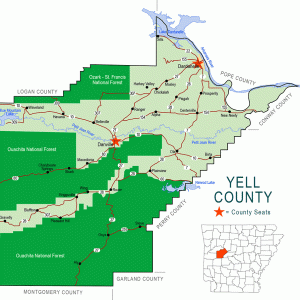calsfoundation@cals.org
Harkey Valley (Yell County)
Harkey Valley, often referred to as “Harkey’s Valley,” is a community located in Yell County between County Roads 38 and 39. Located southwest of Dardanelle (Yell County), the community is bordered by Chickalah (Yell County) on Highway 27, which lies approximately ten miles to the east, and the Mount Magazine Division of the Ozark National Forest to the west. Portions of the community are located within the forest itself. The community’s history is closely associated with the neighboring community of Sulphur Springs (Yell County), which lies slightly to the north. Both areas are often referred to as simply “the valley.” County Road 38, which leads from Chickalah to Harkey’s Valley and Sulphur Springs, was renamed “Harkey’s Valley Road.” Therefore, many newcomers consider all points along the road to be part of Harkey Valley as well.
Harkey Valley derives its name from the Harkey family who originally settled the area in the mid-1800s. One of the most well-known members of the Harkey family was also one of the early entrepreneurs of Ola (Yell County), John Mathias Harkey. He came to Yell County from Texas in 1851. Having served as a Confederate army captain in the Civil War, he returned to the nearby Ola area to build numerous businesses, including a sawmill, flour mill, gristmill, and, eventually, a mercantile store. He also played a large role in the development of the railroad in the region, an economic venture that would connect the timber and cotton markets to the nearby river port town of Dardanelle.
During the mid-1800s through the 1940s, Harkey Valley was a semi-populated farming and logging community, economically connected to nearby Chickalah, Shoal Creek, and other rural communities throughout western Yell County. Although it never developed into commercial center, in the late 1800s it was home to the Bill Winner sawmill and other small temporary sawmills. Mail was delivered from the communities of Hobart and Utley before these communities merged with New Blaine (Logan County). There was no Harkey Valley school, and according to oral histories, school-age citizens in the early 1900s went to the New Gateley School (near Sulphur Springs) or Union Grove schools (close to New Blaine). Most families made their living by subsistence farming and cutting logs that were sold to nearby sawmills and driven to Dardanelle, where they were shipped down the river. The use of mule teams was common in the logging industry until the mid-1950s, and many area families relied on equines to supplement their income. Many young men and some families also worked as migrant laborers in California during picking seasons, returning to the valley periodically.
In 1933, the federal government acquired much of the land in the area, including portions of the Magazine Mountain District, which was then considered part of the Ouachita National Forest. Oral histories conducted in the area reveal that many of the men recalled working, or hearing about their fathers working, on the Civilian Conservation Corps (CCC) project in nearby Spring Lake Dam. Around this same time, the U.S. Forest Service began acquiring more land to enlarge the Mount Magazine District. In 1941, President Franklin D. Roosevelt transferred the Mount Magazine District from the Ouachita National Forest to the Ozark National Forest, where it remains today. As the logging industry died out and access to transportation increased, families began to move away from Harkey Valley, Sulphur Springs, and other rural communities.
Today, the “valley” is a rural area dotted with cattle and chicken farms and some natural gas wells. There is a great deal of land open for hunting, which remains a popular pastime in the region. Many people drive to Dardanelle, Danville (Yell County), or other neighboring communities for work and school. Harkey Valley is home to the Harkey’s Valley Cemetery, donated by William Monroe and Emma Dooley Harkey in the early 1900s. Today, the cemetery is located on Forest Service land about seven miles from where Chickalah Creek crosses Highway 27. Many of the tombstones date from the mid-1800s and include numerous unmarked fieldstones. In the twenty-first century, community members still participate in Decoration Day on the third Sunday of May, when they decorate graves with brightly colored flowers, visit with one another, and tend to the cemetery.
For additional information:
Banks, Wayne. History of Yell County, Arkansas.Van Buren, AR: The Press Argus, 1959.
Yell County Historical and Genealogical Association. Yell County Heritage: A History of Yell County, Arkansas. Bedford, TX: Curtis Media, Inc., 1997.
Meredith Martin-Moats
McElroy House: Organization for Folklife,
Oral History and Community Action
 Harkey Valley
Harkey Valley  Yell County Map
Yell County Map 




Comments
No comments on this entry yet.